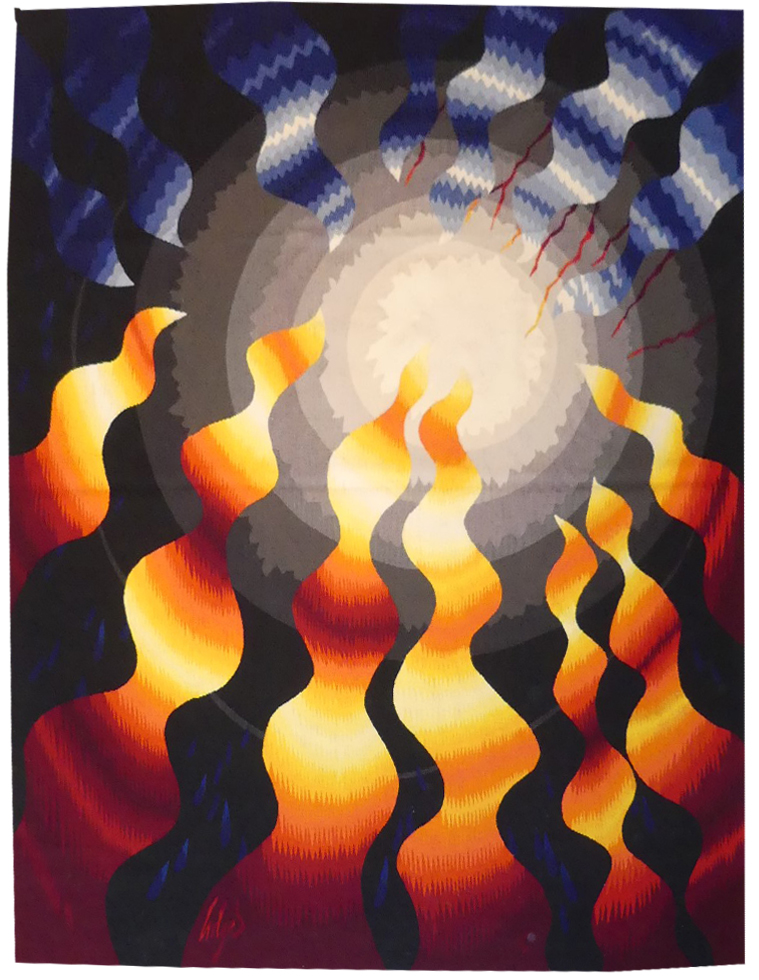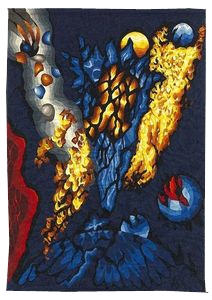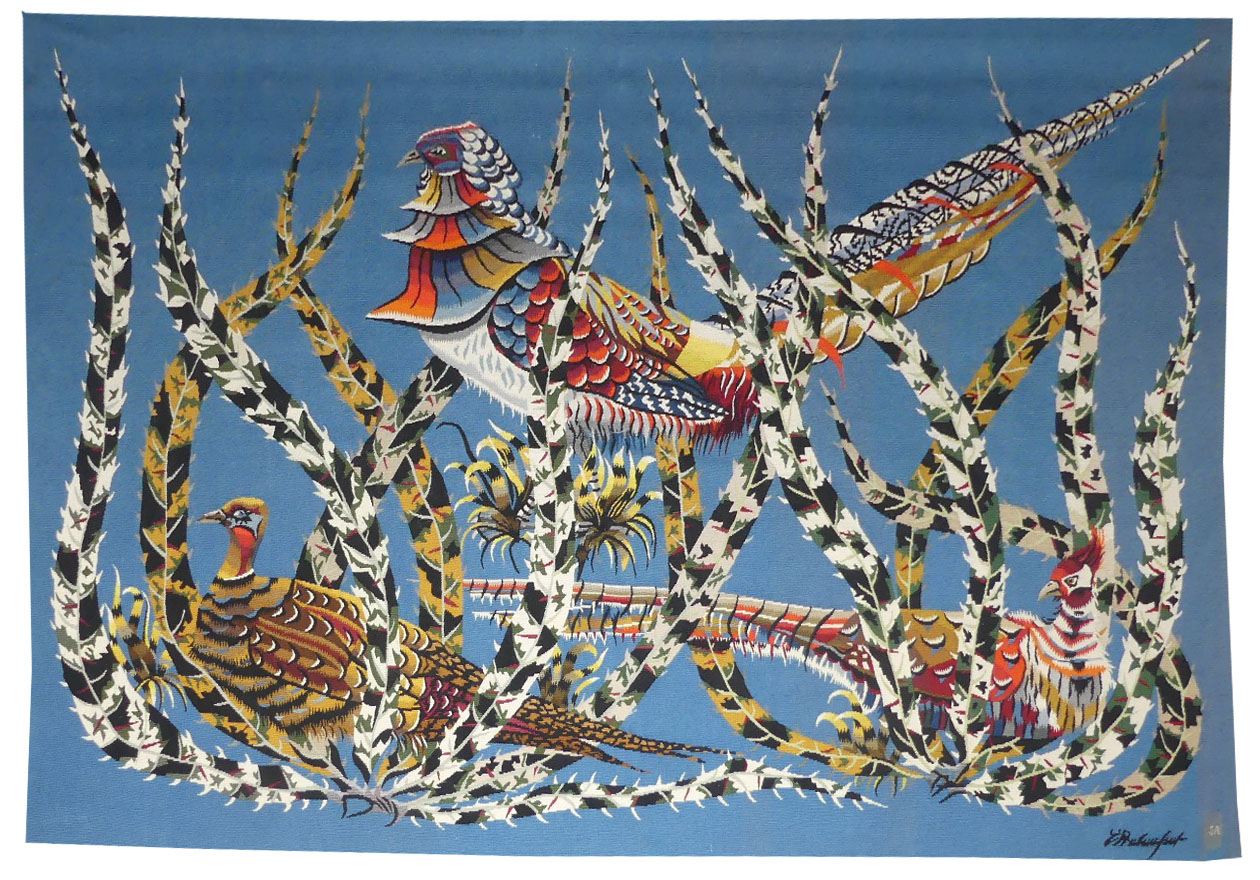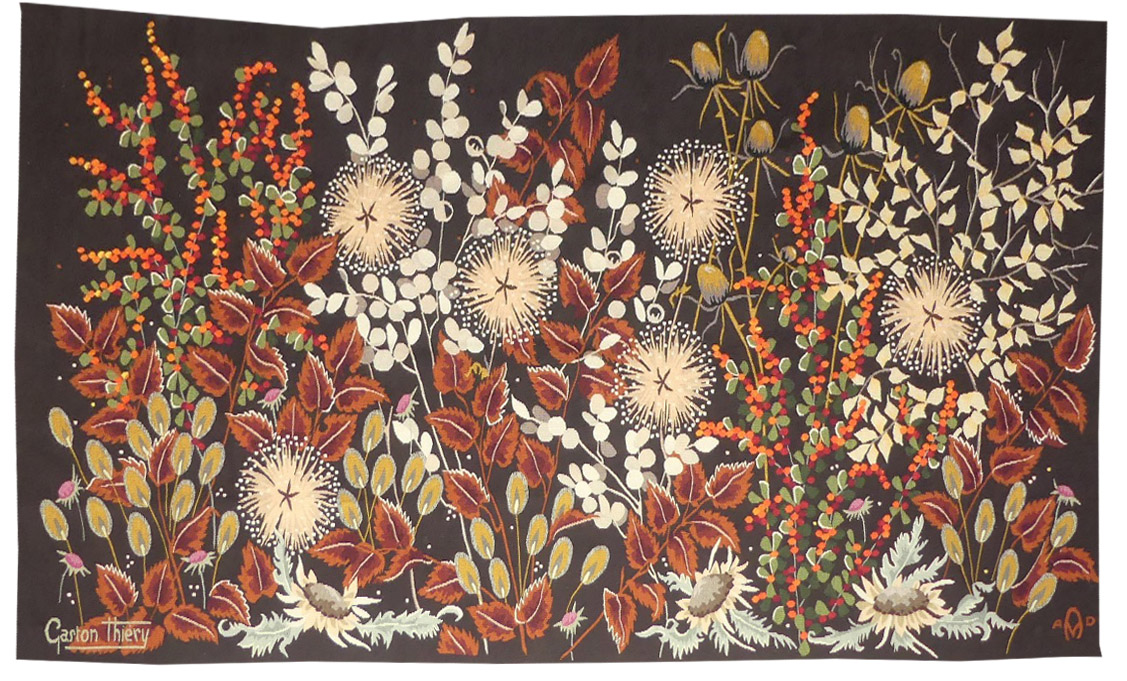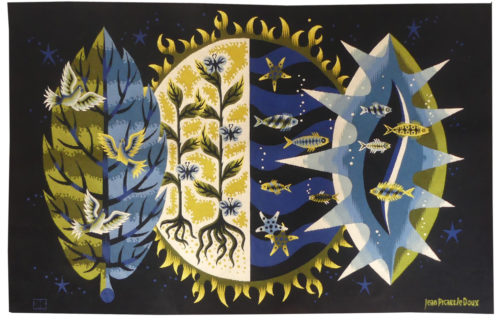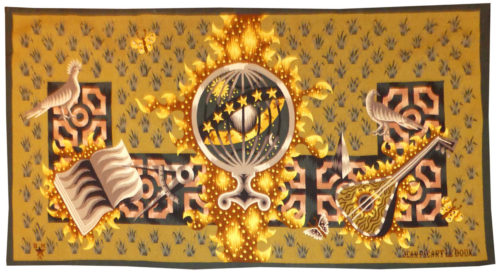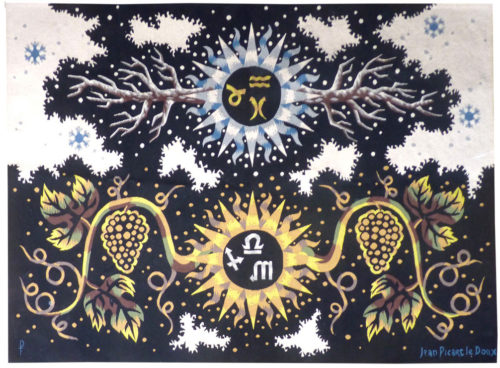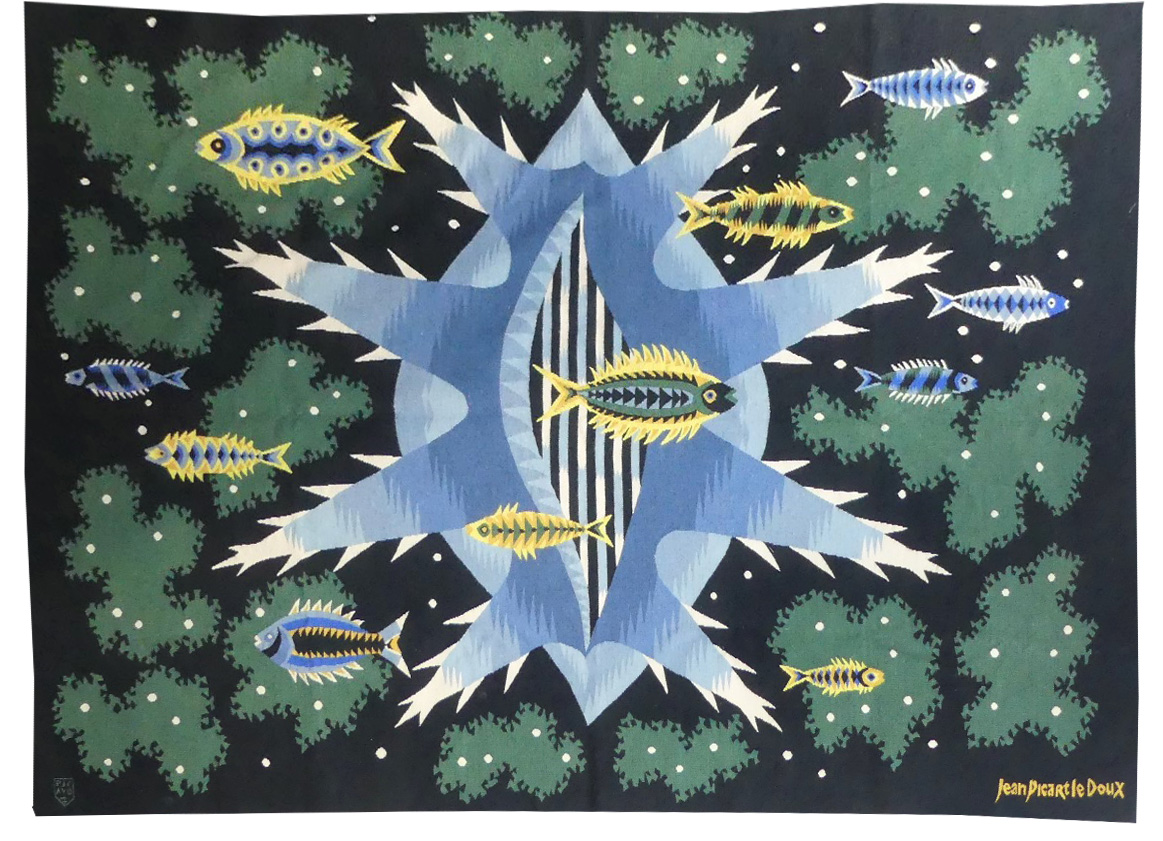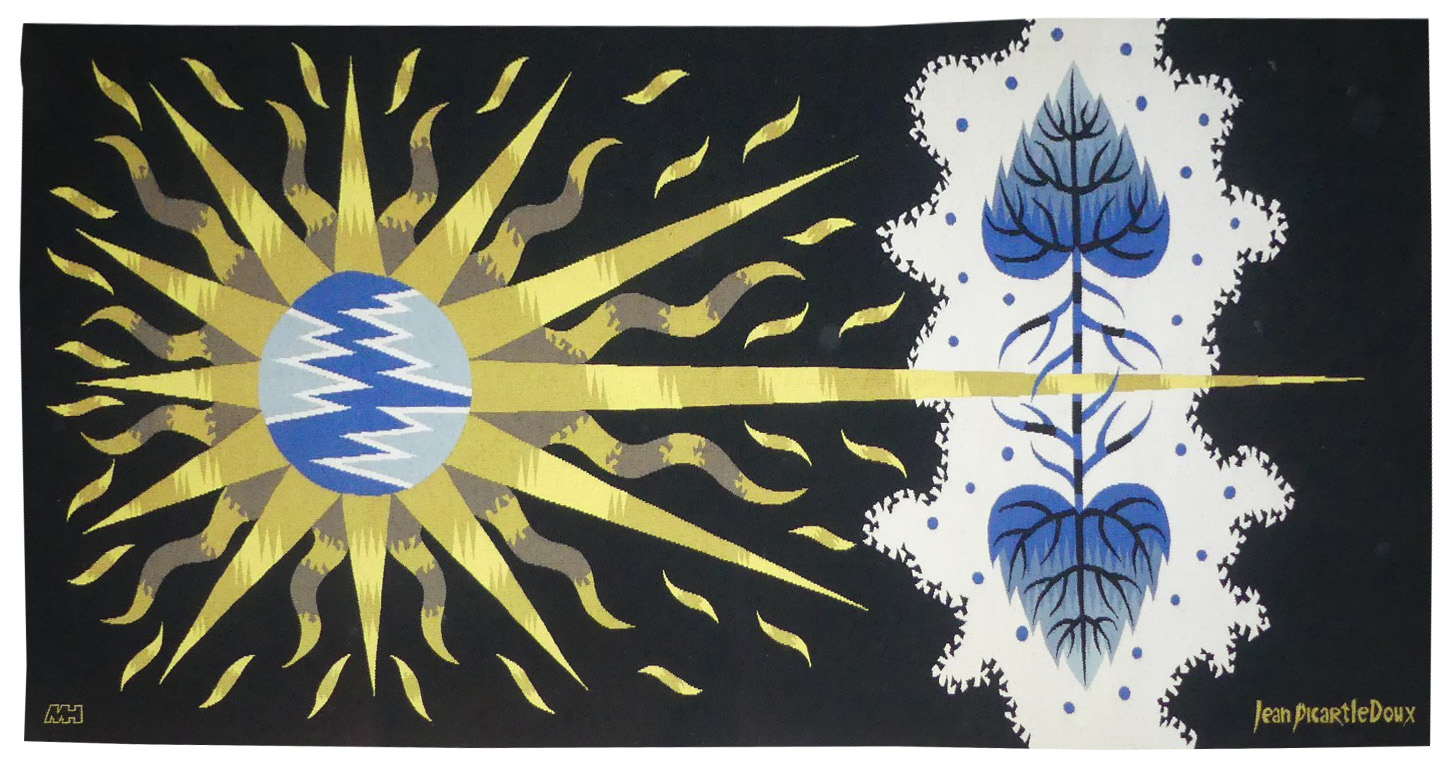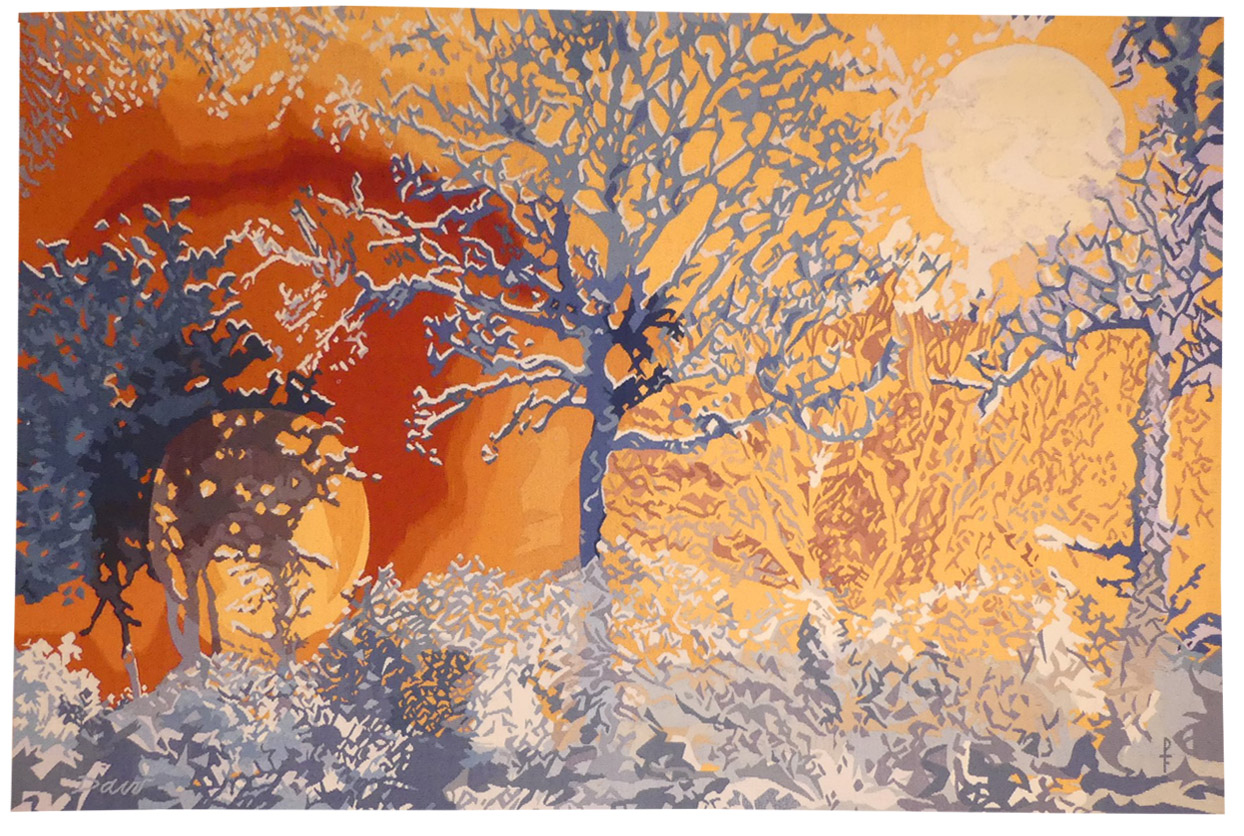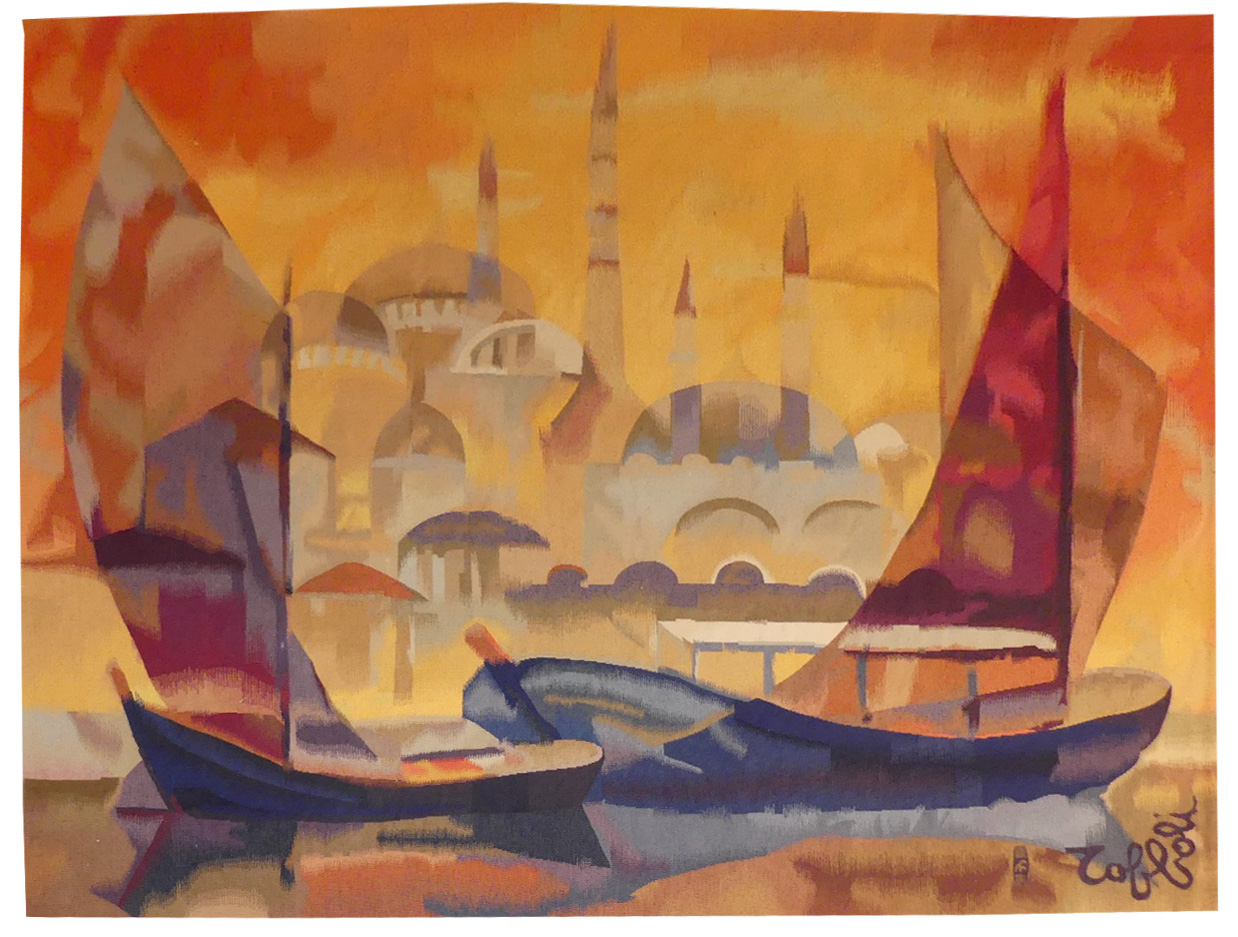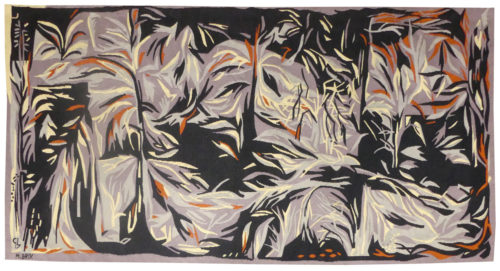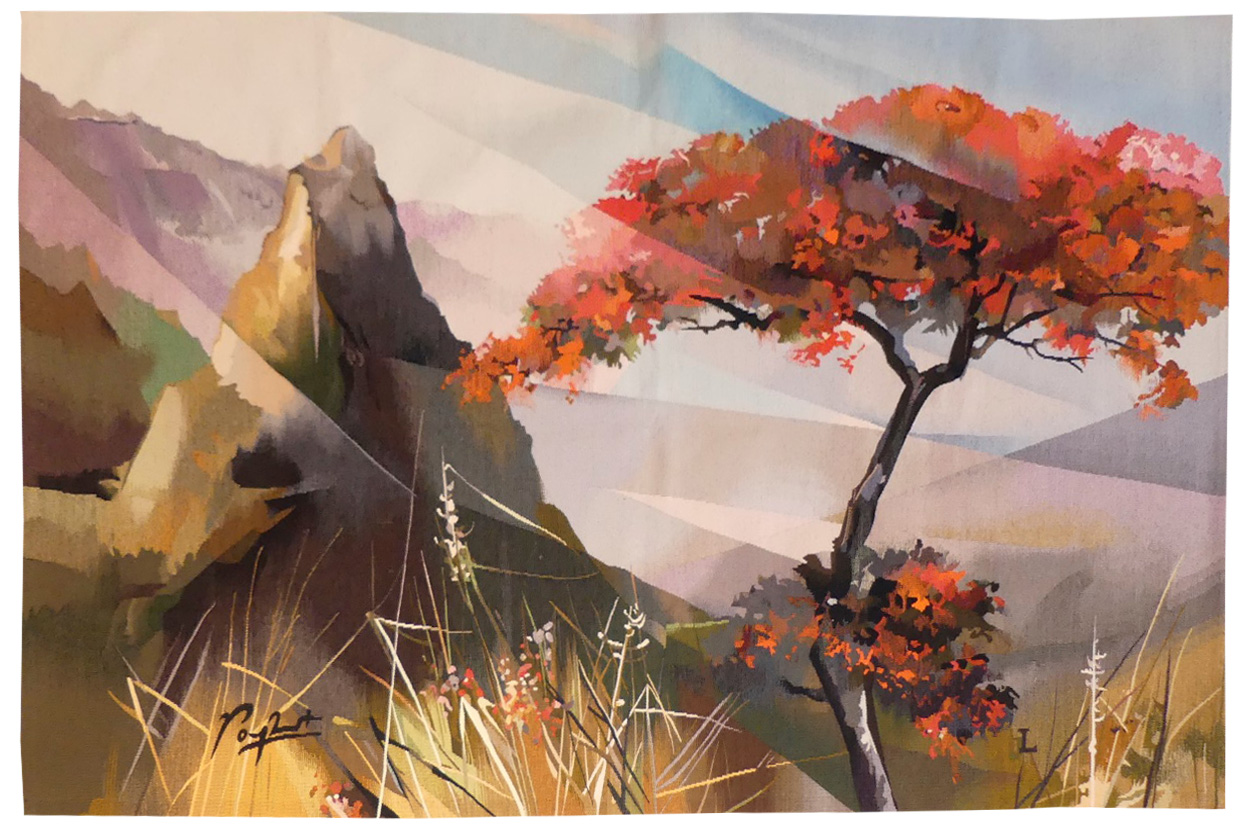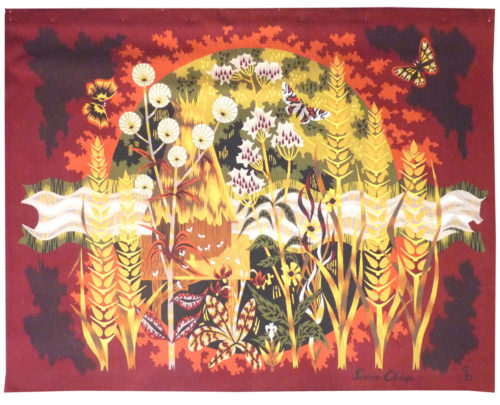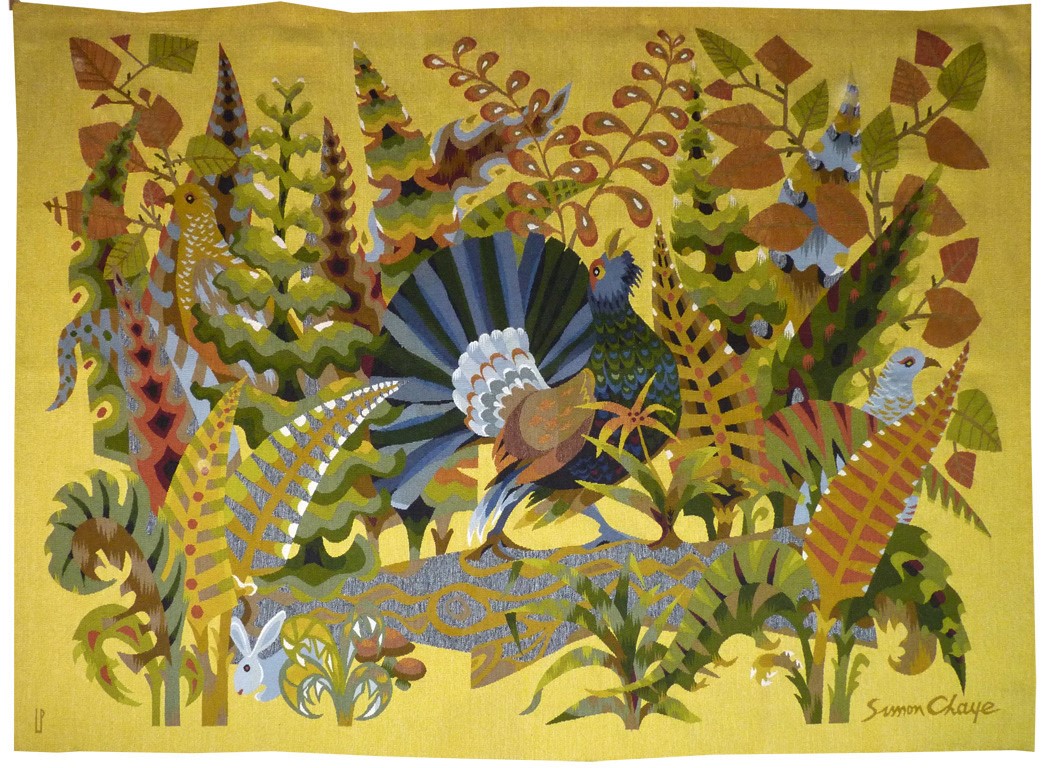-
Holger was a student at the Ecole Nationale d’Art Décoratif d’Aubusson and worked with Lurçat before the latter’s death in 1966. He designed numerous dream-like cartoons woven by the Aubusson workshop. Now settled in the United States, he remains a tireless advocate for, and witness to, modern tapestry design, organising exhibitions and lectures on the subject.
Kosmische Vision (Cosmic vision)
Aubusson tapestry woven in the Pintron frères workshop. With certificate of origin. Circa 1970. -
Edmond Dubrunfaut can be considered as the great 20th century renovator of the Belgian tapestry tradition. He founded a weavers’ workshop in Tournai as early as 1942, then, in 1947, created the Centre de Rénovation de la Tapisserie de Tournai. He produced for various Belgian workshops (Chaudoir, de Wit,...) numerous cartoons destined notably to adorn Belgian embassies throughout the world. Moreover, Dubrunfaut was a teacher of monumental art forms at the Academie des Beaux-Arts de Mons from 1947 to 1978 and then, in 1979, contributed to the creation of the Fondation de la tapisserie, des arts du tissu et des arts muraux de Tournai, a veritable heritage centre for the art of the tapestry in Wallonie. His style, characterised by figuration, strong colour contrasts, draws direct inspiration from nature and animal life (as with Perrot, for example, this artist has a net predilection for birdlife). Both the subject and the bright blue background are an echo of Perrot’s work. Also characteristic of Dubrunfaut are the feather-leaves : the animal clothes itself in vegetation.Aubusson tapestry woven in the Simone André workshop. With signed label. Circa 1965.
-
Féérie automnale (automn wonder)
A student of Léon Detroy, Gaston Thiéry is one of the last representatives of the Crozant school of painting. Estalished in the Creuse region of France, he started working on tapestries in 1965 with the Andraud workshop for whom he designed cartoons inspired by the local flora, in a decorative style which can be situated somewhere between that of Dom Robert and Maingonnat, a world away from his landscape paintings which were strongly influenced by the impressionists.Aubusson tapestry woven in the Andraud workshop. With label, n°EA2. 1977. -
La terre et la mer II (Earth and sea II)
Aubusson tapestry woven by the Hecquet workshop. With label signed by the artist's widow, n°1/6. 1960. Jean Picart le Doux is one of the foremost figures in the renaissance of the art of tapestry. His earliest contributions to the field date back to 1943 when he designed cartoons for the passenger ship “la Marseillaise”. A close associate of Lurçat, whose theories he would adopt (limited palette, numbered cartoons...), he was a founding member of the A.P.C.T. (Association des Peintres-cartonniers de Tapisserie), and soon after, a teacher at the Ecole Nationale Supérieure des Arts Décoratifs. The state gave him several commissions most of them at the Aubusson workshop, and some at the Gobelins : the most spectacular of these being for the University of Caen, the Theatre in Le Mans, the passenger ship France or the Prefecture of the Creuse département ... In as much as Picart le Doux’s aesthetic is close to that of Lurçat, so also is his inspiration and his subject matter, although in a register which is more decorative than symbolic, where he brings together heavenly bodies (the sun, the moon, the stars...), the elements, nature (wheat, vines, fish, birds...), man, literary quotation ... This cartoon is a smaller reworking of his original version (170 x 272 cm) dating from 1960. At that time, Picart le Doux was beginning his series of binary tapestries with allegorical associations of different elements. A system was being established (fish + shells = water or the sea, butterflies + roots = the earth) which Picard le Doux would use for the rest of his career. Bibliography : Marthe Belle-Joufray, Jean Picart le Doux, Publications filmées d’art et d’histoire, 1966 Maurice Bruzeau, Jean Picart le Doux, Murs de soleil, Editions Cercle d’art, 1972, n°103 Exhibition Catalogue, Jean Picart le Doux, tapisseries, Musée de Saint-Denis, 1976 Exhibition Catalogue Jean Picart le Doux, Musée de la Poste, 1980 -
Sphère et colombes (Sphere and doves)
Aubusson tapestry woven in the Berthaut workshop. Complete with signed label. Circa 1954. Jean Picart le Doux is one of the foremost figures in the renaissance of the art of tapestry. His earliest contributions to the field date back to 1943 when he designed cartoons for the passenger ship “la Marseillaise”. A close associate of Lurçat, whose theories he would adopt (limited palette, numbered cartoons...), he was a founding member of the A.P.C.T. (Association des Peintres-cartonniers de Tapisserie), and soon after, a teacher at the Ecole Nationale Supérieure des Arts Décoratifs. The state gave him several commissions most of them at the Aubusson workshop, and some at the Gobelins : the most spectacular of these being for the University of Caen, the Theatre in Le Mans, the passenger ship France or the Prefecture of the Creuse département ... In as much as Picart le Doux’s aesthetic is close to that of Lurçat, so also is his inspiration and his subject matter, although in a register which is more decorative than symbolic, where he brings together heavenly bodies (the sun, the moon, the stars...), the elements, nature (wheat, vines, fish, birds...), man, literary quotation ... Typical of the associations that characterise his work, Picart le Doux here confronts Nature (organised in a formal French garden style) peopled by doves with 3 allegories : literature (a book) the arts (a mandoline), science (a sphere) : the incarnation of a classical mind. Bibliography : Maurice Bruzeau, Jean Picart le Doux, Murs de soleil, Editions Cercle d’art, 1972 Exhibition Catalogue, Jean Picart le Doux, tapisseries, Musée de Saint-Denis, 1976 Exhibition Catalogue Jean Picart le Doux, Musée de la Poste, 1980 -
Automne-Hiver (Autumn-Winter)
Aubusson tapestry woven by the Pinton workshop. Complete with certificate of origin n° 6 of 6. Circa 1975. Jean Picart le Doux is one of the foremost figures in the renaissance of the art of tapestry. His earliest contributions to the field date back to 1943 when he designed cartoons for the passenger ship “la Marseillaise”. A close associate of Lurçat, whose theories he would adopt (limited palette, numbered cartoons...), he was a founding member of the A.P.C.T. (Association des Peintres-cartonniers de Tapisserie), and soon after, a teacher at the Ecole Nationale Supérieure des Arts Décoratifs. The state gave him several commissions most of them at the Aubusson workshop, and some at the Gobelins : the most spectacular of these being for the University of Caen, the Theatre in Le Mans, the passenger ship France or the Prefecture of the Creuse département ... In as much as Picart le Doux’s aesthetic is close to that of Lurçat, so also is his insipiration and his subject matter, although in a register which is more decorative than symbolic, where he brings together heavenly bodies (the sun, the moon, the stars...), the elements, nature (wheat, vines, fish, birds...), man, literary quotation ... The theme of the seasons is a classic in the history of tapestry which was enthusiastically ressuscitated by the 20th century cartoon artists, of whom Lurçat was foremost (cf his Seasons wall hanging commissioned by the state in 1939). For Picart le Doux the inspiration is two-fold : Nature obviously but also Music ; “l’Hiver” (Winter) an allegorical treatment of the theme and one of the best-known works of this artist dates from 1950, but it is the “Hommage à Vivaldi” (Homage to Vivaldi) from 1963, with its 4 seasons represented in symbolic fashion by coloured suns, featuring symbols from the zodiac and fronds of vegetation that is the source of this cartoon where the motifs are reworked in a horizontal format. Bibliography : Maurice Bruzeau, Jean Picart le Doux, Murs de soleil, Editions Cercle d'art, 1972 -
Coquillage étoilé II (Starry seashell II)
Aubusson tapestry woven by the Picaud workshop. With label signed by the artist, n°2/6. Circa 1975. Jean Picart le Doux is one of the foremost figures in the renaissance of the art of tapestry. His earliest contributions to the field date back to 1943 when he designed cartoons for the passenger ship “la Marseillaise”. A close associate of Lurçat, whose theories he would adopt (limited palette, numbered cartoons...), he was a founding member of the A.P.C.T. (Association des Peintres-cartonniers de Tapisserie), and soon after, a teacher at the Ecole Nationale Supérieure des Arts Décoratifs. The state gave him several commissions most of them at the Aubusson workshop, and some at the Gobelins : the most spectacular of these being for the University of Caen, the Theatre in Le Mans, the passenger ship France or the Prefecture of the Creuse département ... In as much as Picart le Doux’s aesthetic is close to that of Lurçat, so also is his inspiration and his subject matter, although in a register which is more decorative than symbolic, where he brings together heavenly bodies (the sun, the moon, the stars...), the elements, nature (wheat, vines, fish, birds...), man, literary quotation ... « Coquillage étoilé » (Starry seashell) dates from 1959 and thenceforth the motif reappears regularly, in « l’Eau et le Feu » (Water and Fire) (1959), « la Mer et la Terre » (Sea and Land) (1960) or « l’Homme et la Mer » (The man and the sea) (1964)… as an evocation of the sea. This cartoon places the motif at the centre whilst another tapestry, with the same name, uses a vertical format. Bibliography : Marthe Belle-Joufray, Jean Picart le Doux, Publications filmées d’art et d’histoire, 1966 Maurice Bruzeau, Jean Picart le Doux, Murs de soleil, Editions Cercle d’art, 1972 Exhibition Catalogue, Jean Picart le Doux, tapisseries, Musée de Saint-Denis, 1976 Exhibition Catalogue Jean Picart le Doux, Musée de la Poste, 1980 -
Germination
Aubusson tapestry woven by the Henry workshop. With signed label, n°2/6. Circa 1980. Jean Picart le Doux is one of the foremost figures in the renaissance of the art of tapestry. His earliest contributions to the field date back to 1943 when he designed cartoons for the passenger ship “la Marseillaise”. A close associate of Lurçat, whose theories he would adopt (limited palette, numbered cartoons...), he was a founding member of the A.P.C.T. (Association des Peintres-cartonniers de Tapisserie), and soon after, a teacher at the Ecole Nationale Supérieure des Arts Décoratifs. The state gave him several commissions most of them at the Aubusson workshop, and some at the Gobelins : the most spectacular of these being for the University of Caen, the Theatre in Le Mans, the passenger ship France or the Prefecture of the Creuse département ... In as much as Picart le Doux’s aesthetic is close to that of Lurçat, so also is his inspiration and his subject matter, although in a register which is more decorative than symbolic, where he brings together heavenly bodies (the sun, the moon, the stars...), the elements, nature (wheat, vines, fish, birds...), man, literary quotation ... The association of two elements is extremely common in the work of Picart le Doux : it allows for the complementary presentation of two elements day/night , sea/sky, land/sea…. In the association presented here we see Nature as one and unified, the sun warms the plant and thus produces « Germination » Bibliography : Marthe Belle-Joufray, Jean Picart le Doux, Publications filmées d’art et d’histoire, 1966 Maurice Bruzeau, Jean Picart le Doux, Murs de soleil, Editions Cercle d’art, 1972 Exhibition Catalogue, Jean Picart le Doux, tapisseries, Musée de Saint-Denis, 1976 Exhibition Catalogue Jean Picart le Doux, Musée de la Poste, 1980 -
Le sultan (the sultan)
Lurçat’s artistic production was immense : it is however his role as the renovator of the art of tapestry design which ensures his lasting renown. As early as 1917, he started producing works on canvas, then in the 20’s and 30’s, he worked with Marie Cuttoli. His first collaboration with the Gobelins workshop dates back to 1937, at the same time he discovered the tapestry of the Apocalypse which was essential in his decision to devote himself to tapestry design. He first tackled the technical aspects with François Tabard, then on his installation at Aubusson during the war, he established his technique : broad point, a simplified palette, outlined cartoons with colours indicated by pre-ordained numbers. A huge production then follows (over 1000 cartoons) amplified by his desire to include his painter friends, the creation of the A.P.C.T. (Association des Peintres-Cartonniers de Tapisserie) and the collaboration with the art gallery La Demeure and Denise Majorel, and then by his role as a tireless advocate for the medium around the world. His tapestries reveal a pictorial world which is specifically decorative, with a very personal symbolic iconography : cosmogony (the sun, the planets, the zodiac, the four elements…) stylised vegetation, fauna (rams, cocks, butterflies, chimera …) standing out against a background without perspective (voluntarily different from painting) and, in his more ambitious work, designed as an invitation to share in a poetic (he sometimes weaves quotations into his tapestries) and philosophical (the grand themes are broached from the wartime period onwards) vision whose climax is the “Chant du Monde” (Song of the World) (Jean Lurçat Museum , ancien hôpital Saint Jean, Angers) which remained unfinished at his death. ‘Le Sultan’ is an inverted version of “Fanfares”, with changes to the detail of the rooster's plumage. Although the rooster is a leitmotif for Lurçat, it can take on different meanings: here, in glory, on a large scale (3.5 m²), it bears witness to the Victory of 1945 (note the tricolour allusions), it is a festive rooster, deployed in a profusion of coloured areas. Bibliography : Tapisseries de Jean Lurçat 1939-1957, Pierre Vorms Editeur, 1957 Exhibition Catalogue Lurçat, 10 ans après, Musée d'Art moderne de la ville de Paris, 1976 Exhibition catalogue Les domaines de Jean Lurçat, Angers, Musée Jean Lurçat et de la tapisserie contemporaine, 1986 Symposium Jean Lurçat et la renaissance de la tapisserie in Aubusson, Aubusson, Musée départemental de la tapisserie 1992 Exhibition Catalogue Dialogues avec Lurçat, Musées de Basse-Normandie, 1992 Exhibition catalogue Jean Lurçat, Donation Simone Lurçat, Académie des Beaux-Arts, 2004 Jean Lurçat, le chant du monde Angers 2007 Gérard Denizeau, Jean Lurçat, Liénart, 2013 Exhibition Catalogue Jean Lurçat au seul bruit du soleil, Paris, galerie des Gobelins, 2016Aubusson tapestry woven in the Tabard workshop. With signed label. Circa 1945. -
Byzance (Byzantium)
Toffoli produced a large number of tapestries in collaboration with the Robert Four workshop from 1976 onwards, designing several hundred cartoons. In them we find post-cubist transparent effects which are characteristic of the artist, as indeed are the subjects treated. Thus Toffoli’s tapestries do not differ from his painting : here the dome of Hagia Sophia and the Bosphorus transport the observer elsewhere.Aubusson tapestry woven by the Four workshop. With label, n°3/6. Circa 1980. -
Rêve gris (Grey dream)
An unreferenced artist, Monique Brix submitted a few tapestry cartoons to Aubusson which were woven by the Glaudin-Brivet or Pinton workshops.Aubusson tapestry woven by the Glaudin-Brivet workshop. With signed label, n°6/6. Circa 1980. -
Paysage au flamboyant (landscape with flamboyant)
In a similar vein to Toffoli, Raymond Poulet criss-crossed the world and his travels provided the themes that inspired his work.Aubusson tapestry woven by the Jean Laurent workshop. N°6/6. Circa 1990. -
L’enclos (Enclosure)
Aubusson tapestry woven in the Brivet workshop. With signed label, n°4/4. 1966.It was in 1953 that Jean Picart le Doux proposed to Chaye to become his assistant and encouraged him to design tapestry cartoons : he would produce numerous bucolic cartoons, but also views of Normandy (Mont Saint Michel, Honfleur, regattas,...) from whence he came. Here is a thoroughly characteristic cartoon of this artist who specialises in pastures, hedges and woodland scenes. -
Le grand tétras (Capercaillie)
Aubusson tapestry woven by the Legoueix workshop. With signed label, n°2/6. Circa 1970. It was in 1953 that Jean Picart le Doux proposed to Chaye to become his assistant and encouraged him to design tapestry cartoons : he would produce numerous bucolic cartoons, but also views of Normandy (Mont Saint Michel, Honfleur, regattas,…) from whence he came. Here is a thoroughly characteristic cartoon of this artist who specialises in pastures, hedges and woodland scenes.


